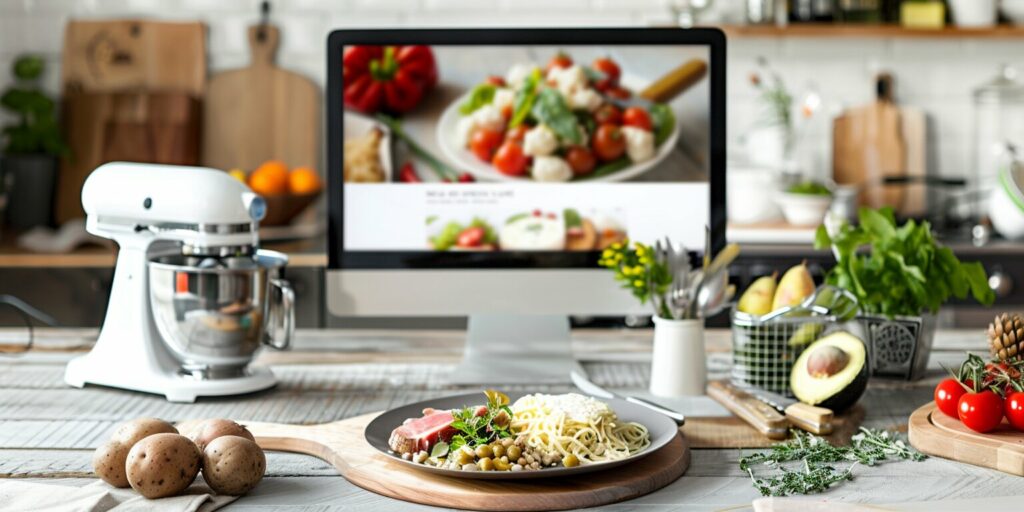Welcome to the exciting world of food blogging. Here, your love for cooking and sharing online comes together. In the vast online world, standing out can be tough. How can you ensure your amazing recipes are noticed?
SEO is essential for food bloggers. It’s about making your site visible in online searches. With the right SEO strategies, you can pull in more readers, which means growing your audience and making your blog a success.
This article will help you explore SEO for food bloggers. You’ll learn how it can improve your online presence. We’ll cover how to optimize your food blog and do keyword research. If you want your recipes to shine among the rest, let’s learn about SEO. It’s a tool that can truly change your food blogging journey for the better!
Understanding SEO for Food Blogs
Knowing about food blog SEO is vital to making your food blog more visible on search engines. Stay up to date with the latest Google updates and use SEO strategies for food blogs. Doing this will boost your blog’s ranking and draw in more readers.
Staying Up-to-Date with Google Algorithm Updates
Google updates its search algorithms often to match users with the best search results. As a food blogger, keeping track of these changes and adjusting your SEO plans is critical. This way, your blog will stay search engine friendly and keep appearing in top search results.
Optimizing Your Food Blog for SEO
Improving your blog’s visibility in search engines calls for several techniques. Here are some important ones:
- Keyword research: Find the right keywords for your food niche and use them wisely in your content.
- On-page optimization: Use proper headings, meta descriptions, and alt tags on images to boost your posts.
- Quality content creation: Make interesting and helpful posts that connect with your readers and search engines.
- Mobile optimization: Make sure your blog looks good and works well on mobile devices since many people use them.
- User experience: Enhance users’ enjoyment of your site by making it load fast, using clear URLs, and being easy to navigate.
- Link building: Get good links from other food bloggers to increase your blog’s trustworthiness and relevance.
These SEO techniques designed for food blogs can help your site rank better and attract more visitors.
Now, let’s look into why doing keyword research in your food niche is important. We’ll also discuss how to use those keywords to improve your blog content.
Conducting Keyword Research for Your Food Niche

Great keyword research is key to boosting your food blog on search engines. It’s about finding the best search terms for your food area. This way, you draw in more people naturally and show up better on search results. There are a few steps to get this right:
- Understand your target audience: Know and think about your readers and what they like. Think about what words they would use to find recipes or food information. It’s important to consider their favorite foods, diets, and cooking styles.
- Utilize keyword research tools: Use tools like Google Keyword Planner, SEMrush, and Ahrefs to find good keywords. Try different tools to see which one helps you the most.
- Analyze competitor keywords: Check out what keywords your competition is using. This can show you new keywords to focus on. Look for areas in your food niche that others haven’t explored much.
- Focus on long-tail keywords: Long-tail keywords are specific but attract a targeted audience. They have lower search volumes but often attract more dedicated users, which can boost the success of your content.
- Consider user intent: Understand what users really want when they search. Are they looking for recipes, how to cook something, or replacements for ingredients? Knowing this helps you create content that meets their needs. It can also help improve how high you show up in searches.
After picking the right keywords, making your content work well is crucial. Next, we’ll look at ways to make the most of your keyword research. This will boost your blog’s reach and importance.
Optimizing On-Page SEO for Recipes
Optimizing your recipe pages for search engines is key in food blogging. Use specific on-page SEO techniques for food blogs to improve the visibility of your recipes in search results. We’ll examine vital elements of recipe page optimization.
1. Metadata
Good recipe metadata boosts your search engine rankings. Be sure to use important keywords in your page’s title, meta description, and meta tags. Make your title and description catchy, so they tempt people to click on your recipe.
2. Headings
Using correct headings makes your content easier for people to read. It also helps search engines understand your content better. Use clear and keyword-filled H1, H2, and H3 tags on your recipe page to increase its value for SEO.
3. URLs
Create understandable and clean URLs for your recipes. This helps users and search engines find your pages. Use keywords in your URLs, and separate them with hyphens for better readability.
4. Image Optimization
- Give your recipe images clear filenames that include keywords.
- Use alt tags on your images that describe the image and include keywords.
- Compress your images so your pages load faster, improving your ranking.
5. Keyword Placement
It’s important to place keywords wisely on your recipe page. Use your main keywords naturally in the title, headings, and content. Don’t overuse them, though, as this can hurt your rankings.
6. Mobile Responsiveness
Having mobile-friendly pages is crucial as more people look at recipes on their phones. A responsive design makes the user experience better and can boost your rankings.
Using these on-page SEO tips will help your recipes rank higher in searches. But always remember, creating valuable and interesting content is the most important thing. It ensures your blog’s long-term success.
Enhancing Website Ranking through Link Building
Link building is key for improving website ranking and domain authority for food bloggers. It involves creating a network of links that direct users to your site. With a strong backlink profile, your food blog will be seen as more credible and visible.

So, what is link building exactly? It’s about getting other websites to link back to yours. These links are like votes of confidence for your blog. They tell search engines your site is trustworthy and deserves a higher ranking.
Link building has big benefits for food bloggers. It makes it easier for search engines to find their content. When well-known websites link to your blog, search engines notice it more.
Also, link building boosts your domain authority. This means search engines see your content as more reliable. As a result, your blog may rank higher and get more visitors from search results.
Effective Link-Building Strategies for Food Bloggers
Now, let’s explore some link-building strategies for food bloggers:
- Create High-Quality Content: Create content that’s worth linking to. This includes standout recipes, articles, and images. Such content can attract quality backlinks.
- Guest Blogging: Write for other food blogs and include a link to yours. Guest posting gets you backlinks and introduces your blog to new readers.
- Collaborate with Influencers: Work with influencers or other bloggers in your niche. Promote each other’s blogs and posts to expand your audiences and get backlinks.
- Reach out to Brands and Websites: Contact brands and websites related to your niche. Discuss how you can work together or ask for backlinks to your blog.
- Engage in Food Blogging Communities: Join food blogging groups online. Share your knowledge and blog links where appropriate. This helps you connect with other bloggers and build backlinks naturally.
Remember, having a few high-quality backlinks is better than having many low-quality ones. Focus on getting backlinks from trusted sources in the food blogging world. This approach will improve your ranking.
Creating Engaging and SEO-Friendly Content
Running a successful food blog means making content that connects with your readers. Making your posts rank well in search engine results is also key. This helps your blog get seen more and attracts a bigger audience. Here’s how food bloggers can boost engagement and SEO:
Conduct Keyword Research
Begin with keyword research. Find out what search terms are hot in your food niche. Tools like Google Keyword Planner, SEMrush, or Moz Keyword Explorer can help. These tools can show the keywords that could bring more visitors to your blog. Naturally, include these keywords in your posts to rank better in searches.
Write Captivating Headlines
The headlines of your blog posts are vital for grabbing your reader’s interest. Create titles that are both captivating and informative, including important keywords. A strong headline can increase your post’s visibility in search results and make more people click on it.
Optimize Images and Videos
Images and videos are key for interesting content. Make sure to name your images and give them alt tags that include relevant keywords. Also, compress large images for faster loading times, which search engines like. Add keywords to titles, descriptions, and tags for videos to help them appear in searches.
Create Comprehensive and Informative Content
Write detailed and informative posts that offer real value to your audience. Longer posts often do better in search results. Insert keywords naturally throughout the content, but don’t overdo it. Aim to provide top-quality, well-researched information that keeps readers interested and makes them want to share your post.
Structure Your Content for Readability
Splice your content into smaller segments and use clear headings to break it down. Lists and bulleted points are your friends. They make your writing easier to read quickly. Aim for a logical piece that guides readers and helps search engines make sense of your content.
Encourage Social Sharing
Adding social sharing buttons makes it easy for readers to spread the word about your content. More shares mean more eyes on your posts, potentially boosting your blog’s reach and search ranking.
Using these tips will help you create captivating content that is also SEO-friendly. It’s all about engaging your readers while following good SEO practices. By striking this balance, your food blog can enjoy lasting success.
Measuring and Analyzing SEO Success
Understanding how well your SEO is working is crucial. It’s about examining certain measures and using the right tools. This helps you see if your website is getting better rankings and if more people are coming from web searches.

One important thing to check is where your blog posts show up in search results. You need to see if they appear for the keywords you’re targeting. This way, you know if your changes are actually working. And, looking at how your visibility changes over time can tell you if your SEO plan is effective.
When working on SEO, it’s also key to watch the volume and quality of visitors to your site. Google Analytics is a good tool for this. You’ll look at things like how many people visit from searches, how long they stay, and if they leave quickly. This helps see if your content is drawing in the right audience.
Checking your backlinks is another big part of SEO success. Quality backlinks from trusted sites can boost your ranking. Ahrefs and Moz are tools that show how many quality backlinks your site has. Keep an eye on this info to find new linking chances and see how your efforts are helping.
Key Metrics for Measuring SEO Success:
- Keyword rankings on SERPs
- Organic search traffic volume
- Bounce rates and average session durations
- Backlink quantity and quality
Remember, keeping track of SEO is something you do all the time. Regularly check your progress with these metrics. It will help you spot where you can do better and tweak your SEO strategy. By always trying to do better and monitoring your SEO, your website’s ranking and traffic will likely go up.
Conclusion
Today, standing out in the online food blogging scene demands SEO. With the right optimization, bloggers can draw more readers and improve their success.
SEO’s many parts are all important. You need to know SEO for food blogs, pick good keywords and strengthen your site and links.
Your content must be interesting and easy to find. It should keep readers happy and increase your site’s ranking. Stay updated with SEO changes to beat your rivals.
It’s crucial to check if your SEO work is paying off. Watch how your site ranks and gets traffic from searches. This helps you fine-tune your strategy based on what really works.





